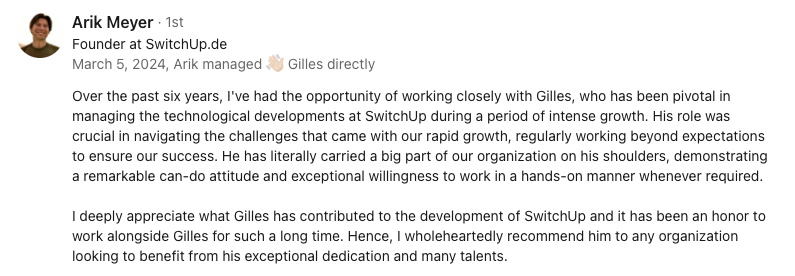Abstract:
Fostering holistic work environments is essential for promoting employee well-being and ensuring sustained productivity. This approach goes beyond traditional wellness programs by integrating mental, physical, and emotional health into the workplace culture. A holistic work environment recognizes the varied needs of its employees, offering flexible work arrangements, resources for mental health, and opportunities for personal and professional growth. By prioritizing the well-being of employees, companies can create a supportive and engaging atmosphere that not only enhances job satisfaction but also attracts and retains top talent. Achieving such a workplace requires commitment from leadership to adopt policies and practices that support a balanced, healthy work life for all employees.
holistic work environments and their importance
As someone deeply embedded in the tech and engineering sectors, I've often observed how traditional workplace wellness programs fall short of addressing the complete needs of our teams. It’s not just about offering gym memberships or the occasional mindfulness session. What we’re finding out is that fostering holistic work environments can elevate not only individual well-being but also the overall culture of our organizations. And let's be honest – who wouldn’t want a truly harmonious workplace where both productivity and happiness flourish?
A holistic work environment goes beyond the basics. It integrates mental, physical, and emotional health into the very fabric of our workplace culture. This comprehensive approach doesn’t just promote well-being; it creates a community where people genuinely thrive. Here’s where it gets interesting: by addressing employees' diverse needs, we build a supportive culture that feels more like a second home rather than just the place we come to for eight hours a day.
It’s kind of like making a well-rounded meal – you can’t just focus on the dessert (although who doesn’t love dessert, right?). You need all the nutritional components to ensure a balanced, satisfying experience. Similarly, a holistic work environment carefully blends elements that support the whole person. We must consider:
- Mental health support: Regular mental health days, access to counseling services, and a culture that openly discusses mental health struggles.
- Physical wellness: Flexible schedules for physical activity, ergonomic workspaces, and healthy meal options.
- Emotional well-being: Building meaningful interpersonal relationships, creating spaces for informal gatherings, and fostering an atmosphere of respect and empathy.
So why is this so important? Because when people feel valued and supported in all aspects of their lives, they bring their best selves to work. And let’s be honest – a happier, healthier team means fewer sick days, higher productivity, and a more innovative, energetic workplace. Who wouldn't want to be part of that?
components of a holistic work environment
Creating a holistic work environment might sound like a daunting task, but it’s essentially about providing the right mix of elements that cater to various aspects of an employee’s well-being. Think of it as assembling the ingredients for a deliciously balanced smoothie – each component may be great on its own, but together, they create something truly nourishing. Let's break down these key components:
mental health support
Mental wellness is often overlooked in traditional workplace setups, yet it’s critical for a truly holistic environment. Companies can provide:
- Counseling services: Offering access to professional counseling can make a world of difference to employees dealing with stress, anxiety, or other mental health issues.
- Mental health days: These are not just sick days. Designating specific days for mental well-being allows employees to recharge, thus preventing burnout.
- Open conversations: Encouraging a culture where mental health is openly discussed helps in removing the stigma and makes employees feel supported.
physical wellness
The connection between physical health and productivity at work is undeniable. Companies can take practical steps to enhance physical wellness by offering:
- Flexible schedules: Letting employees manage their time to accommodate physical activity can boost both health and morale. Think of it as letting them play the ‘Rocky’ training montage whenever they need it.
- Ergonomic workspaces: Investing in adjustable chairs, standing desks, and other ergonomic tools reduces physical strain and enhances comfort.
- Healthy meal options: Stock the office pantry with nutritious snacks instead of just the usual suspects like chips and sugary drinks.
emotional well-being
Emotional well-being is the glue that can hold all other components together, fostering a sense of belonging and respect among employees. Companies can focus on the following:
- Building relationships: Encouraging team-building activities and social events can foster meaningful interpersonal relationships. It’s like creating your extended family at work – the ones you actually want to spend time with.
- Informal gathering spaces: Architectural considerations matter. Designing spaces where employees can have informal conversations, whether it be a cozy lounge area or a casual coffee corner, encourages spontaneous interactions.
- Atmosphere of respect and empathy: It’s essential to cultivate a culture where everyone feels heard and valued. Regularly celebrating achievements and providing constructive feedback can help maintain this vibe.
flexible work arrangements
Work-life balance is crucial in a holistic work environment. Offering flexible work arrangements can significantly enhance an employee's overall well-being:
- Remote work options: Allowing employees to work from home or other remote locations provides them the flexibility to manage their personal and professional responsibilities effectively.
- Flexible working hours: Not everyone is at their best from 9 to 5. Providing flexible working hours lets employees choose when they’re most productive.
- Compressed workweeks: For those who prefer a longer weekend, the option to work longer hours for fewer days can be a game-changer.
personal and professional growth opportunities
Growth and development are like the yeast in bread-making – they help everything rise. Companies can support this by providing:
- Professional development programs: Offering workshops, courses, and training sessions helps employees advance their careers and acquire new skills.
- Mentorship programs: Pairing less experienced employees with seasoned professionals creates a valuable learning environment and builds strong professional networks.
- Clear career paths: Ensuring that employees have a clear understanding of how they can grow within the organization motivates them to put their best foot forward.
Incorporating these components into a holistic work environment requires commitment, but the payoff is immense. Employees feel valued, supported, and more connected to their work and their teams. And who wouldn’t want to work in a place where everyone thrives together? It’s like hitting the workplace jackpot!
benefits of fostering a holistic work environment
Investing in a holistic work environment isn’t just about having warm, fuzzy feelings toward our employees (though that’s a nice perk). It’s about tangible, measurable benefits that can transform our workplaces into hubs of creativity, productivity, and overall satisfaction. By prioritizing employee well-being, we create a supportive and engaging atmosphere that radiates positivity throughout the entire company.
enhanced job satisfaction
Let’s start with job satisfaction. When employees feel valued and supported in all aspects of their lives – mentally, physically, and emotionally – their job satisfaction naturally increases. It’s like upgrading from economy class to business class; everything just feels better, smoother, more comfortable. Employees who are content in their roles are more likely to stay, reducing turnover and the associated costs of recruitment and training. Plus, satisfied employees are our best brand ambassadors; they speak positively about the company, which enhances our reputation in the industry.
attracting and retaining top talent
One of the most significant challenges many companies face today is attracting and retaining top talent. A holistic work environment can be a powerful magnet for the industry’s best and brightest. When we promote a culture that emphasizes comprehensive well-being, it signals to potential hires that we care about more than just their work output. We’re invested in their long-term growth and happiness. This kind of commitment stands out. Imagine interviewing at two companies: one offers a typical 9-to-5 grind, while the other promotes mental health days, flexible work hours, and personal development opportunities. It’s a no-brainer which one seems more appealing.
And retaining these top talents? That's the cherry on the sundae. Top-performing employees feel genuine loyalty when their holistic needs are met. They are less likely to jump ship for a marginally higher salary because they value the overall experience and support they receive. It’s like finding your perfect pair of jeans; once you do, you’re not going shopping anytime soon.
increased productivity
Happy, healthy employees are productive employees. When our teams are not bogged down by stress, poor health, or burnout, they can genuinely focus on bringing their A-game. By supporting the mental, physical, and emotional needs of our employees, we’re effectively handing them the keys to unlock their full potential. Think of it as maintaining a high-performance car: regular tune-ups, quality fuel, and preemptive care ensure it runs at its best.
Moreover, fostering a holistic environment encourages innovation and creativity. When people are comfortable, confident, and supported, they’re more likely to take risks and think outside the box. It’s in these conditions that breakthroughs and game-changing ideas are most likely to occur.
improved corporate culture
Another less obvious, but equally vital benefit is the positive impact on corporate culture. A holistic approach fosters a community spirit within the workplace. It’s like swapping out division and rivalry for camaraderie and mutual respect. When employees see that the organization genuinely cares about their well-being, it nurtures loyalty and a strong sense of belonging. It’s no longer just a workplace; it’s a community.
reduced absenteeism
Let’s not forget the practical financial benefits. Reduced absenteeism is a massive plus. When employees are healthier and happier, they take fewer sick days. This leads to fewer disruptions in workflow and a more stable, consistent output. Think of it as having a team that’s always in the game, ready to score.
real-life examples
Consider companies like Google and Salesforce, known for their comprehensive well-being programs. These organizations report higher levels of employee engagement, lower turnover rates, and better overall performance – all because they prioritize a holistic approach. Google’s campus, for instance, integrates everything from gyms and healthy cafeterias to mental health resources and meditation centers. Such facilities may sound extravagant, but the results speak for themselves: higher productivity, enhanced innovation, and a strong, positive corporate culture.
In conclusion, fostering a holistic work environment is not just a feel-good initiative. It’s a strategic investment in our people that pays dividends in job satisfaction, talent retention, productivity, and overall company success. Plus, it makes coming to work a whole lot more enjoyable – for everyone involved. And who wouldn’t want to be part of a workplace like that?
leadership commitment to holistic practices
Creating a genuinely holistic work environment isn't a task that can be accomplished with just a few policies or initiatives. It requires a true commitment from leadership to make a significant impact. As a leader, it's essential to not only advocate for these practices but to actively participate and model them as well. After all, change starts from the top.
lead by example
First and foremost, leaders need to walk the talk. If I expect my team to take mental health seriously, then I need to show them that I do too. This means taking mental health days when needed, participating in wellness activities, and being open about my own challenges and how I manage them. Transparency in these areas can cultivate a more open and supportive workplace culture. It's hard for employees to take wellness policies seriously if they see their leaders burning the midnight oil and neglecting their own well-being.
policy and program development
Developing and implementing policies that support a holistic work environment is a key responsibility of leadership. This involves:
- Comprehensive wellness programs: These should cover mental, physical, and emotional health. It’s about creating a balanced menu that caters to diverse needs.
- Clear communication: Wellness policies and programs need to be clearly communicated to all employees. This ensures everyone is aware of the resources available to them and how to access these resources.
- Feedback mechanisms: Encourage and establish ways for employees to provide feedback on wellness initiatives. This will help in continuously improving the programs to better meet their needs.
It’s worth noting that policies alone won't suffice without the enthusiasm and backing of leadership. Think of it as setting sail on a sturdy ship. You need the wind in your sails – and in this case, that wind is the unwavering support and enthusiasm from leadership.
creating a culture of trust and support
A crucial element of fostering holistic practices is creating a culture where trust and support are paramount. This can be achieved through:
- Open door policies: Ensure that employees feel comfortable coming forward with their concerns, whether they’re related to work or personal issues.
- Regular check-ins: Conduct regular, informal check-ins with team members to gauge their well-being and offer support where needed. It’s like having a chat with a friend – it doesn’t always have to be about projects and deadlines.
- Celebrating successes: Publicly acknowledging and celebrating personal and professional milestones enhances morale and fosters a sense of community. Everyone enjoys a pat on the back, right?
investing in continuous learning
Leadership commitment also extends to investing in continuous learning and development, both for themselves and their teams. This encompasses:
- Ongoing education: Staying informed about the latest trends and research in workplace wellness helps in evolving and refining wellness programs.
- Training and workshops: Regularly offering training that focuses on stress management, work-life balance, and other relevant topics can provide employees with practical tools to enhance their well-being.
By embodying these principles and practices, leaders can effectively cultivate a workplace where holistic well-being is not just an initiative but a foundational element of the company culture. And here’s the kicker: when our teams see us genuinely invested in their overall well-being, they’re more likely to reciprocate with loyalty, dedication, and motivation. It’s a win-win for everyone involved.
So let's commit to a holistic work environment, not just because it’s the right thing to do, but because it makes our workplaces thrive. Plus, it's a lot more enjoyable to work in a place that feels more like a supportive community rather than just a collection of desks and deadlines.
You might be interested by these articles:
- Creating Wholesome Workspaces for Employee Wellness
- Transforming Workspaces: How European Startups Boost Employee Well-being with Tech
- Harnessing Cultural Diversity for Innovation in Europe's Tech Industry





